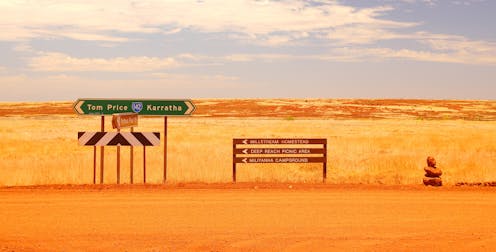To boost Indigenous employment, we need to map job opportunities to skills and qualifications. Our new project does just that
- Written by Claire Mason, Principal Research Scientist, CSIRO

For employers wanting to recruit Indigenous workers, two key factors stand in their way: geography combined with lack of job diversity, and a mismatch between educational qualifications and job opportunities.
We’ve charted this mismatch with the Indigenous Jobs Map[1], using artificial intelligence to analyse more than 10 million job ads.
The map, is an Indigenous-led project supported by researchers and experts across CSIRO and external organisations.
It identifies three types of Indigenous-related job ads: those seeking an Indigenous candidate; those seeking “cultural capability” (for which a non-Indigenous candidate might also qualify); and jobs for which Indigenous candidates are encouraged to apply.
Using AI to analyse all job ads posted in Australia between 2016 and 2022, we calculate:
about 10% of all ads encouraged Indigenous applicants. These were ads stating that applications from Aboriginal and Torres Strait Islander peoples were welcomed or encouraged.
about 2% were for roles that required Indigenous cultural knowledge, skills and expertise, or experience working with Aboriginal and Torres Strait Islander people.
about 1% were for roles that only Indigenous peoples can apply for (or which give priority to Indigenous applicants in the selection process). These roles typically involve direct interaction with Aboriginal and/or Torres Strait Islander communities.
Of course, Indigenous workers can apply for any job, regardless of whether it specifically targets or encourages Aboriginal and Torres Strait Islander applicants.
However, the 2.3% of job ads for Indigenous people or requiring Indigenous cultural capability reflects the strong demand for Indigenous talent in the Australian labour market.
The number of these advertisements is increasing; in 2016 they represented 1.0% of Australian job ads and by 2022 they had reached 3.6%. Aboriginal and Torres Strait Islander people comprise about 2% of the workforce (either employed or actively seeking work).
So why aren’t these efforts to attract Indigenous workers making more of a difference?
Geographic mismatch
The infographic illustrates how geography limits these efforts. Each bubble represents a region of Australia. The size of the bubble represents the number of Indigenous workers in the region.
Regions above the horizontal black line have a higher-than-average proportion of Indigenous-focused job ads. Regions below this line have fewer Indigenous-focused job postings than average.
Regions to the left of the vertical line have a lower-than-average proportion of Indigenous workers in their labour market. Regions to the right have a higher-than-average proportion of Indigenous workers.
If demand for Indigenous workers was aligned with supply, most regions would be positioned on, or near the red diagonal line.
Instead, we see many regions where demand for Indigenous workers is relatively high but the supply of Indigenous workers is relatively low.
The Ballarat region in Victoria illustrates this disparity, with 2,910 Indigenous- focused job ads compared to an Indigenous workforce of 640 individuals. In contrast, in the New England region of New South Wales, there were 5,821 Indigenous workers and 2,483 Indigenous-focused job ads.
In other words, employers are recruiting for Indigenous talent in the wrong places.
Limited range of job types
There is also a lack of diversity in the roles being advertised. Most are in just three sectors: public administration and safety; health care and social assistance; and education and training. A disproportionate number are for community and personal-service worker roles.
This strong sector-specific demand does not align with the qualifications of the Indigenous workforce.
For example, we counted 7,610 Indigenous focused job ads requiring a qualification in medicine. But the 2021 Census[2] counted just 585 Indigenous people holding their highest qualification in medicine.
The following chart illustrates these demand and supply differences according to educational field.
The size of each bubble reflects the number of Indigenous workers with formal qualifications in this field. The position of the bubble (to the left or right of the vertical line) reflects the proportion of Indigenous-focused job ads that require this qualification.
Employers post job ads seeking Indigenous workers with qualifications in society and culture, health and education. While Indigenous workers are likely to have qualifications in society and culture, they are not well represented in health and education. Indigenous workers are better represented in fields such as agriculture and environment, society and culture and food, hospitality and personal services.
Job ads targeting Indigenous workers are not found across the board. When we look across all jobs ads (not just those targeting Indigenous workers), management and commerce qualifications are in highest demand. The opportunities for Indigenous workers are limited in diversity and often not well-aligned with the educational pathways commonly chosen by Indigenous peoples.
Feast and famine
The effect of this geographic and qualification mismatch is to create a landscape of feast (for some) and famine (for many others).
For instance, in Melbourne there were more than 60,000 Indigenous-focused job ads for each Indigenous worker in the region with an Information Systems qualification.
On the flip side, there were very few employers targeting Indigenous workers with a building qualification. For example, in Townsville there was one Indigenous-focused job ad for the 128 Indigenous workers with a qualification in building.
By understanding the career pathways of Indigenous peoples and tailoring their workforce strategies to align with the locations and qualifications held by Indigenous peoples, employers can do more to ensure that they are successful in their efforts to attract Indigenous workers.
Education is key
Remote work arrangements can help mitigate the geographic mismatch between current demand for and supply of Indigenous talent. But, ultimately, improving job opportunities for Indigenous Australians requires a whole-of-ecosystem approach involving Indigenous communities, educators, employers and policy makers.
The visible growth in employers’ efforts to recruit Indigenous workers represents positive change. The Indigenous Jobs Map reveals how these efforts can be directed more effectively so they translate into employment outcomes.
Read more: Indigenous-owned businesses are key to closing the employment gap[3]
The data also confirms education is the key pathway to highly skilled and well-paid employment. A Bachelor’s degree is most highly sought after, being required in 22.5% of Indigenous focused job ads. Effort needs to be directed towards improving the number of Indigenous people gaining higher educational qualifications.
By engaging Indigenous students in schools, employers can help students and carers understand how their unique knowledge and approach add value in the workplace. Connecting directly and early with Indigenous communities will improve the pipeline of Indigenous talent and ultimately, achieve a more inclusive labour market.
References
- ^ Indigenous Jobs Map (indigenous-jobsmap.csiro.au)
- ^ 2021 Census (www.abs.gov.au)
- ^ Indigenous-owned businesses are key to closing the employment gap (theconversation.com)
Authors: Claire Mason, Principal Research Scientist, CSIRO














